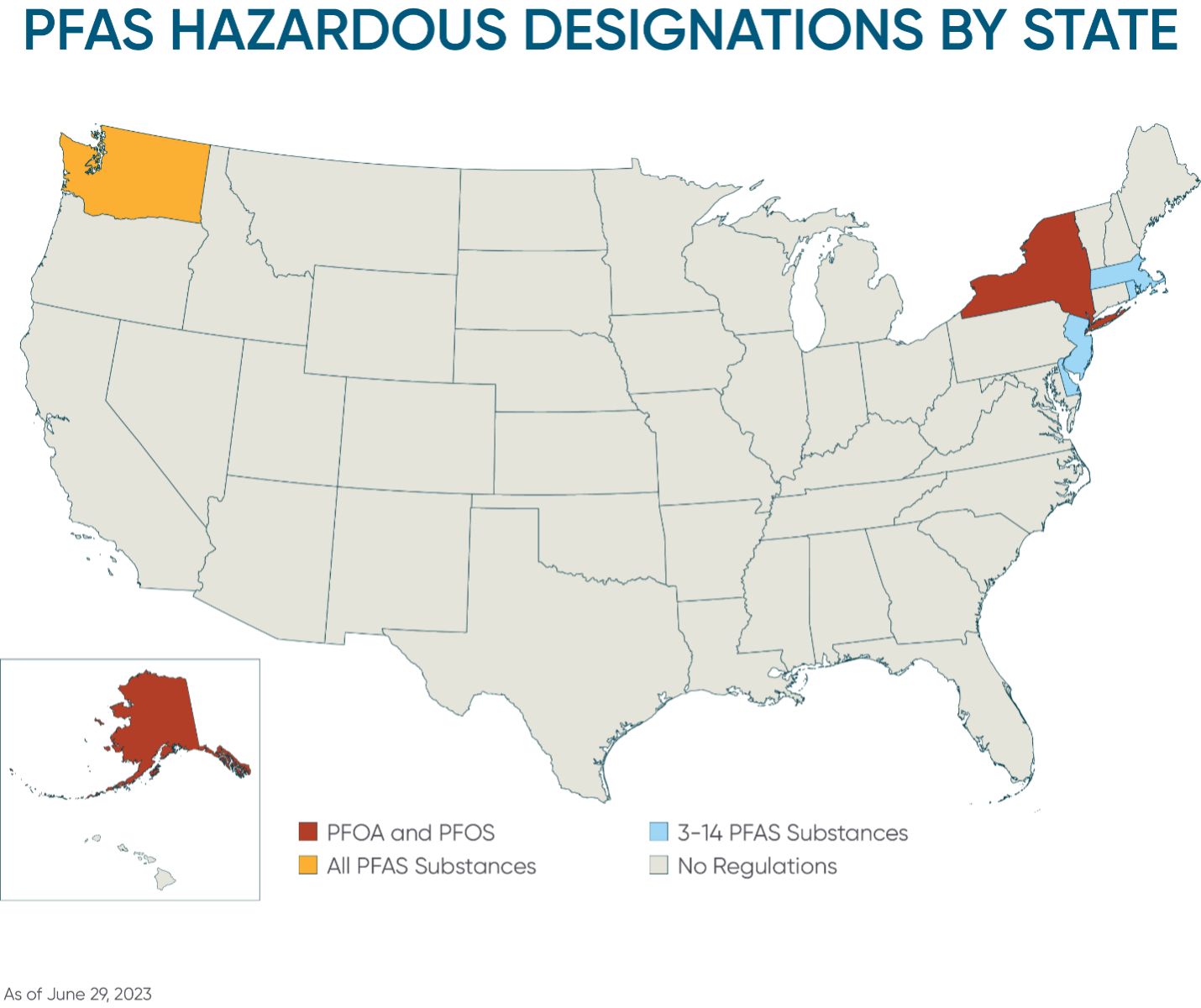Insights
State and Federal Hazardous Substance Listings, July 2023
Jul 10, 2023States and the United States Environmental Protection Agency (“EPA”) have started the process of regulating per- and polyfluoroalkyl substances (“PFAS”) as hazardous substances, and the regulations are expected to accelerate over the coming years. Those listings empower states and EPA to order the investigation and remediation of PFAS compounds, including the possible re-opener of closed sites, and will require the evaluation of PFAS compounds during site diligence in order to satisfy the All Appropriate Inquiries (“AAI”) standard.
I. EPA Hazardous Substance Designations Under CERCLA
EPA has been working on listing PFOA and PFOS as Hazardous Substances under the Comprehensive Environmental Response, Compensation, and Liability Act of 1980 (“CERCLA”) for several years, and was scheduled to complete the process in September 2023. However, EPA recently announced that it will complete the process in February of 2024 instead.
EPA also recently released an Advanced Notice of Proposed Rulemaking soliciting public comments on a proposal that it might list: (1) an additional seven specific PFAS compounds as Hazardous Substances; (2) the precursors and degradation compounds of all listed PFAS designated as Hazardous Substances; and (3) the undefined concept of “categories” of PFAS, indicating an intent to continue to expand the scope of the chemistry that will be subject to CERCLA. Industry groups have already raised significant concerns with all three proposed categories, but for a more detailed analysis on the proposed rulemaking, please see our prior Client Alert on the topics.
Once individual PFAS compounds – or “categories” if that proposal moves forward – are listed as Hazardous Substances under CERCLA, those compounds must be included in Phase I Environmental Site Assessments (“Phase I”) during site due diligence for all real estate transactions nationally in order for buyers to satisfy the AAI standard. In addition, EPA will have the authority to include listed PFAS in site investigation and remediation projects under CERCLA, which, in turn, is expected to give rise to contribution claims related to the new costs of PFAS cleanup.
II. State Hazardous Substance Designations
While EPA continues to work through its listing process, the regulatory landscape at the state level for PFAS compounds consists of an array of different approaches. So far, seven states have passed laws or promulgated regulations adding PFAS to their Hazardous Substances lists. Some have added all compounds in the PFAS family, while others have limited their listings to specific PFAS compounds. Maine has determined that PFAS substances will be listed as Hazardous Substances under state law when PFAS substances are designated as Hazardous Substances persuant to CERCLA.
The map is current as of June 29, 2023.

Specific Information
PFOA and PFOS
Regulatory Information
Hazardous Substance Definition, Regulation (18 AAC 75), and Related Information
Specific Information
Fourteen PFAS Substances
Regulatory Information
Specific Information
Six PFAS Substances: PFOA, PFOS, PFDA, PFHpA, PFHxS, PFNA
Regulatory Information
Specific Information
Three PFAS Substances: PFOA, PFOS, PFNA
Regulatory Information
Specific Information
Six PFAS Substances: PFOA, PFOS, PFDA, PFHpA, PFHxS, PFNA
Regulatory Information
Specific Information
All PFAS Substances
Regulatory Information
Alabama, Arizona, Arkansas, California, Colorado, Connecticut, Florida, Georgia, Hawaii, Idaho, Illinois, Indiana, Iowa, Kansas, Kentucky, Louisiana, Maine, Maryland, Michigan, Minnesota, Mississippi, Missouri, Montana, Nebraska, Nevada, New Hampshire, New Mexico, North Carolina, North Dakota, Ohio, Oklahoma, Oregon, Pennsylvania, South Carolina, South Dakota, Tennessee, Texas, Utah, Vermont, Virginia, West Virginia, Wisconsin, and Wyoming.
III. Impact on Businesses
State Hazardous Substance designations are important for a number of reasons:
- Regulatory Enforcement Risk. Chemicals which are classified as Hazardous Substances are subject to investigation, remediation, and possibly enforcement under state environmental laws. Businesses that own or operate properties in states where PFAS compounds have been designated as Hazardous Substances should be aware that regulatory action is possible, and should evaluate their potential liability.
- Due Diligence. Under the new ASTM standard for AAI, PFAS compounds are not within scope of AAI unless they are regulated as Hazardous Substances under the laws of the state where the property is located. That means that PFAS compounds are within scope for due diligence in the states listed above if a Phase I is intended to satisfy state requirements.[1]
- Other Regulatory Requirements. In many states, other environmental laws and consumer products laws incorporate their state’s Hazardous Substances list, so a Hazardous Substance listing can have ripple effects through other forms of state regulation.
IV. Conclusion
While there has understandably been a great deal of attention paid to EPA’s proposed listing of PFOA and PFOS as Hazardous Substances under CERCLA, and the new ANPR for additional PFAS compounds, the existing and pending listings at the state level have significant implications for businesses operating in those states.
For more information on PFAS chemicals, and the regulatory and liability risks that they pose, please visit our PFAS webpage. If you have a question about how to manage PFAS risk in any jurisdiction, contact Tom Lee, John Kindschuh, Emma Cormier, or any other member of our PFAS team at Bryan Cave Leighton Paisner LLP.
[1] Footnote 3 to Section 1.1.4 of the ASTM E1527-21 standard provides: “If a Phase I Environmental Site Assessment is being conducted to satisfy state requirements and to qualify for the state (or other jurisdiction) equivalent of LLPs, users and environmental professionals are cautioned and encouraged to consider any differing jurisdictional requirements and definitions while performing the Phase I Environmental Site Assessment. Substances that are outside the scope of this practice (for example, emerging contaminants that are not hazardous substances under CERCLA) may be regulated under state law and may be federally regulated in the future. Although the presence or any release/threatened release of these substances are “non-scope considerations” under this practice, the user may nonetheless decide to include such substances in the defined scope of work for which the environmental professional conducting the Phase I Environmental Site Assessment is engaged.”
Related Capabilities
-
PFAS
-
Environment





